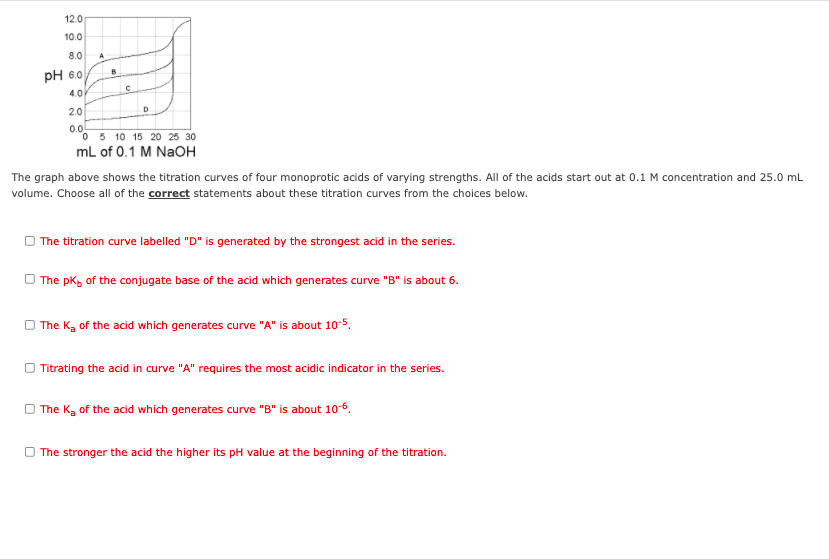12.0 10.0 8.0 pH 6.0 4.0 2.0 O 5 10 15 20 25 30 mL of 0.1 M NaOH The graph above shows the titration curves of four monoprotic acids of varying strengths. All of the acids start out at 0.1 M concentration and 25.0 mL volume. Choose all of the correct statements about these titration curves from the choices below. The titration curve labelled "D" is generated by the strongest acid in the series. O The pk, of the conjugate base of the acid which generates curve "B" is about 6. O The Kg of the acid which generates curve "A" is about 10-5. O Titrating the acid in curve "A" requires the most acidic indicator in the series. O The Kg of the acid which generates curve "B" is about 10-6. O The stronger the acid the higher its pH value at the beginning of the titration.
12.0 10.0 8.0 pH 6.0 4.0 2.0 O 5 10 15 20 25 30 mL of 0.1 M NaOH The graph above shows the titration curves of four monoprotic acids of varying strengths. All of the acids start out at 0.1 M concentration and 25.0 mL volume. Choose all of the correct statements about these titration curves from the choices below. The titration curve labelled "D" is generated by the strongest acid in the series. O The pk, of the conjugate base of the acid which generates curve "B" is about 6. O The Kg of the acid which generates curve "A" is about 10-5. O Titrating the acid in curve "A" requires the most acidic indicator in the series. O The Kg of the acid which generates curve "B" is about 10-6. O The stronger the acid the higher its pH value at the beginning of the titration.
Chapter15: Acid-base Equilibria
Section: Chapter Questions
Problem 90AE: The following plot shows the pH curves for the titrations of various acids by 0.10 M NaOH (all of...
Related questions
Question

Transcribed Image Text:12.0
10.0
8.0
pH 6.0
4.0
D
2.0
0.0
O 5 10 15 20 25 30
mL of 0.1 M NAOH
The graph above shows the titration curves of four monoprotic acids of varying strengths. All of the acids start out at 0.1 M concentration and 25.0 mL
volume. Choose all of the correct statements about these titration curves from the choices below.
O The titration curve labelled "D" is generated by the strongest acid in the series.
O The pk, of the conjugate base of the acid which generates curve "B" is about 6.
O The Ka of the acid which generates curve "A" is about 10-5.
O Titrating the acid in curve "A" requires the most acidic indicator in the series.
O The Ka of the acid which generates curve "B" is about 10-6,
The stronger the acid the higher its pH value at the beginning of the titration.
Expert Solution
This question has been solved!
Explore an expertly crafted, step-by-step solution for a thorough understanding of key concepts.
This is a popular solution!
Trending now
This is a popular solution!
Step by step
Solved in 4 steps

Knowledge Booster
Learn more about
Need a deep-dive on the concept behind this application? Look no further. Learn more about this topic, chemistry and related others by exploring similar questions and additional content below.Recommended textbooks for you


Chemistry: An Atoms First Approach
Chemistry
ISBN:
9781305079243
Author:
Steven S. Zumdahl, Susan A. Zumdahl
Publisher:
Cengage Learning

Chemistry: Principles and Practice
Chemistry
ISBN:
9780534420123
Author:
Daniel L. Reger, Scott R. Goode, David W. Ball, Edward Mercer
Publisher:
Cengage Learning


Chemistry: An Atoms First Approach
Chemistry
ISBN:
9781305079243
Author:
Steven S. Zumdahl, Susan A. Zumdahl
Publisher:
Cengage Learning

Chemistry: Principles and Practice
Chemistry
ISBN:
9780534420123
Author:
Daniel L. Reger, Scott R. Goode, David W. Ball, Edward Mercer
Publisher:
Cengage Learning

Chemistry & Chemical Reactivity
Chemistry
ISBN:
9781337399074
Author:
John C. Kotz, Paul M. Treichel, John Townsend, David Treichel
Publisher:
Cengage Learning

Chemistry & Chemical Reactivity
Chemistry
ISBN:
9781133949640
Author:
John C. Kotz, Paul M. Treichel, John Townsend, David Treichel
Publisher:
Cengage Learning

Chemistry: Principles and Reactions
Chemistry
ISBN:
9781305079373
Author:
William L. Masterton, Cecile N. Hurley
Publisher:
Cengage Learning